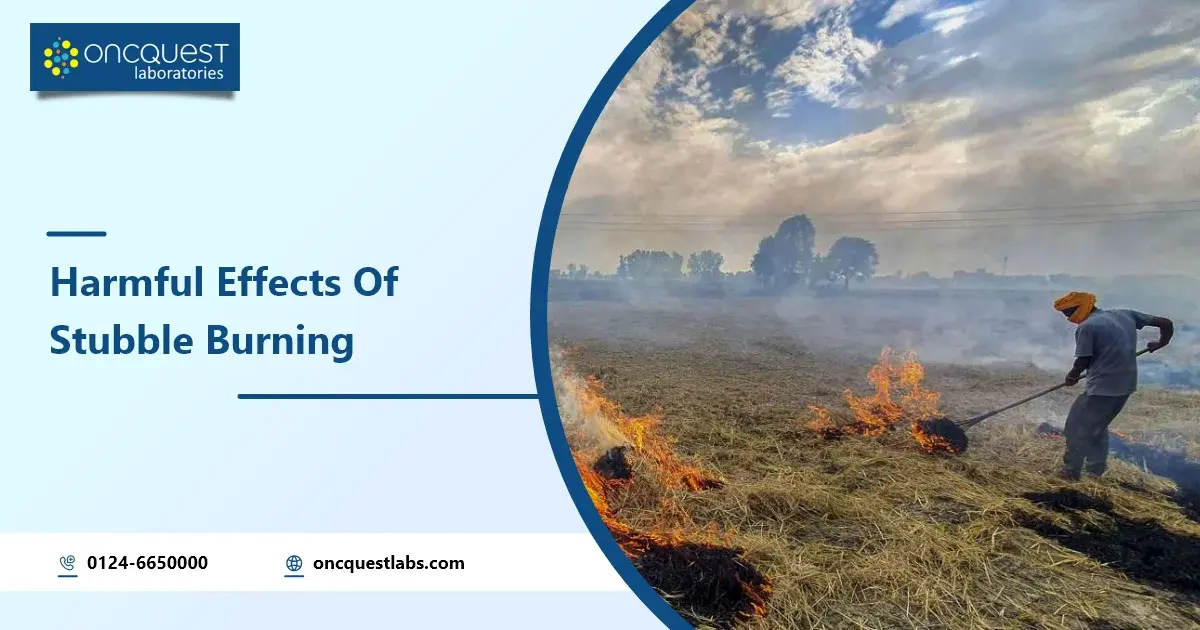In the vast agricultural landscapes, the seasonal practice of stubble burning has become a contentious issue, casting a shadow over the bucolic charm of rural life. While it may seem like a quick solution for farmers to clear their fields, the repercussions of this age-old practice extend far beyond the horizon of the fields themselves. In this blog, we delve into the detrimental effects of stubble burning, exploring the environmental, health, and socio-economic consequences that make it a burning concern for all. Join us as we unravel the layers of this agricultural dilemma and seek sustainable alternatives for a healthier, greener tomorrow.
Contents
What is Stubble?
Stubble refers to the short, remaining stalks of crops left in the field after harvesting. It includes the cut stems and leaves of plants, typically cereal crops like wheat, rice, or maize. Stubble is a byproduct of the harvesting process, and its management is crucial for the health of the soil and the overall sustainability of agriculture. Farmers have various methods to deal with stubble, including plowing it back into the soil as organic matter, using it for animal bedding, or, unfortunately, resorting to stubble burning, which has its own set of environmental concerns.
What is Stubble Burning?
Stubble burning is the agricultural practice of intentionally setting fire to crop residue, such as leftover straw and stubble, after harvesting. This method is often employed by farmers to quickly clear fields for the next planting season. While it provides a swift solution for land preparation, the process releases various pollutants into the atmosphere and contributes to environmental degradation. The impact of stubble burning has raised concerns globally due to its adverse effects on air quality, soil health, and overall ecosystem sustainability.
Why Is Stubble Burning Harmful?
Stubble burning is harmful for several reasons:
- Air Pollution: The process releases harmful pollutants like particulate matter, carbon dioxide, and methane, contributing significantly to air pollution. This compromises respiratory health and worsens existing respiratory conditions.
- Greenhouse Gas Emissions: Stubble burning releases greenhouse gasses, such as carbon dioxide and methane, intensifying global warming and climate change.
- Soil Health Impact: Burning stubble reduces soil fertility by depleting essential nutrients present in crop residues. This negatively affects long-term agricultural productivity.
- Biodiversity Disruption: The intense heat from stubble burning can harm soil-dwelling organisms, disrupting ecosystems and leading to a decline in biodiversity.
- Health Risks: The smoke produced contains harmful substances, posing health risks to humans and animals, including respiratory issues, allergies, and eye irritations.
- Water Quality Concerns: Ash and pollutants from burnt fields can contaminate water bodies, impacting water quality and harming aquatic life.
Overall, stubble burning poses a multifaceted threat to the environment, human health, and agricultural sustainability.
Stubble Burning Effects
- Air Quality Degradation: Stubble burning releases large amounts of particulate matter, carbon dioxide, methane, and other harmful pollutants into the air. This contributes significantly to air pollution, affecting respiratory health and exacerbating existing respiratory conditions.
- Contribution to Greenhouse Gas Emissions: The burning of crop residue emits greenhouse gasses, including carbon dioxide and methane, which contribute to global warming and climate change. This exacerbates the environmental challenges already faced by our planet.
- Soil Health Impairment: Stubble burning results in the loss of essential nutrients present in crop residues. The ashes left behind may contain some nutrients, but the overall impact on soil fertility is negative. This affects long-term agricultural productivity and sustainability.
- Reduced Biodiversity: The intense heat from stubble burning can harm soil-dwelling organisms, affecting the delicate balance of ecosystems. This, in turn, can lead to a decline in biodiversity and disrupt natural processes crucial for a healthy environment.
- Health Risks: The smoke produced during stubble burning contains harmful substances that pose health risks to both humans and animals. Respiratory problems, allergies, and eye irritations are common health issues associated with exposure to the pollutants released.
- Water Quality Concerns: Runoff from burnt fields can carry ash and pollutants into water bodies, impacting water quality. This can harm aquatic life and have cascading effects on ecosystems dependent on these water sources.
Understanding these harmful effects emphasizes the urgency of finding sustainable alternatives to stubble burning for the well-being of both the environment and human health.
Why Do Farmers Burn Stubble?
Farmers often resort to burning stubble for several reasons:
- Quick Field Clearing: Burning stubble provides a fast and efficient way to clear fields after harvesting, allowing for immediate preparation for the next planting season.
- Pest and Disease Control: Stubble burning is believed to help control certain pests and diseases by eliminating crop residues that could harbor harmful organisms. However, this method has limited effectiveness and comes with environmental drawbacks.
- Weed Management: Burning stubble is thought to control weed growth, as the fire can destroy weed seeds and seedlings. However, alternative, more sustainable weed management practices are increasingly being advocated.
- Cost and Time Efficiency: For some farmers, stubble burning is perceived as a cost-effective and time-efficient method compared to other alternatives like plowing or using specialized equipment for residue management.
- Traditional Practices: In some regions, stubble burning has been a traditional agricultural practice passed down through generations, and breaking away from these practices can be challenging due to various factors, including lack of awareness or access to alternative technologies.
Despite its perceived short-term benefits, the environmental and health consequences of stubble burning have prompted calls for more sustainable and eco-friendly alternatives in modern agriculture.
How To Control Stubble Burning
Controlling stubble burning involves implementing alternative practices and encouraging sustainable agricultural methods. Here are some measures:
- Mechanical Residue Management: Encourage the use of modern farm machinery, such as straw balers and choppers, to manage crop residues effectively. These machines can process stubble into mulch or bales, providing an eco-friendly alternative to burning.
- Incentives for Residue Utilization: Governments and agricultural organizations can provide financial incentives or subsidies to farmers adopting residue management techniques that do not involve burning, such as incorporating stubble into the soil.
- Awareness Campaigns: Conduct education and awareness programs to inform farmers about the environmental and health hazards of stubble burning. Promote the benefits of sustainable agricultural practices and provide training on alternative methods.
- Crop Diversification: Encourage farmers to diversify crops, as some crops leave less residue after harvest. This reduces the need for extensive stubble management.
- Promote Conservation Agriculture: Advocate for conservation agriculture practices, such as minimum tillage and cover cropping, which help retain crop residues on the field. This enhances soil health, reduces erosion, and minimizes the need for burning.
- Research and Development: Invest in research and development of innovative technologies for residue management, making it easier and more cost-effective for farmers to adopt sustainable practices.
By combining these approaches and tailoring strategies to local agricultural contexts, it is possible to mitigate stubble burning and promote a more sustainable and environmentally friendly approach to agriculture.
Conclusion
In conclusion, addressing the issue of stubble burning requires a collective and sustained effort. The Northern states of India, notably Punjab, Haryana, Uttar Pradesh, and even Delhi, grapple with the environmental consequences of this practice. While policy measures and awareness campaigns are underway, the transition to sustainable agricultural practices remains paramount. Farmers, policymakers, and communities must collaborate to embrace alternative residue management techniques. By doing so, we can mitigate the harmful effects on air quality, soil health, and overall ecosystem sustainability. The journey towards a greener, healthier future demands a commitment to change and the adoption of innovative, eco-friendly agricultural methods.
Frequently asked Questions
What is the burning of stubble?
Stubble burning, a long-standing agricultural tradition, involves setting crop residue ablaze to swiftly clear fields for subsequent planting. Driven by the imperative to optimize yields, farmers often face time constraints in preparing fields for the next crop. Consequently, the expedient method of burning residue emerges as the go-to solution, facilitating timely sowing amid the pressures of agricultural timelines.
What is the stubble burning activity?
The practice of stubble burning in Northern India emerges as a noteworthy contributor to atmospheric particulate matter (PM) and trace gasses. These emissions not only exert a substantial influence on the local and regional climate but also pose severe health risks to the population.
Why is stubble burning harmful?
Stubble burning contributes to pollution by releasing toxic pollutants into the atmosphere. These harmful emissions include gasses such as Carbon Monoxide (CO), methane (CH4), carcinogenic polycyclic aromatic hydrocarbons, and volatile organic compounds (VOC).





